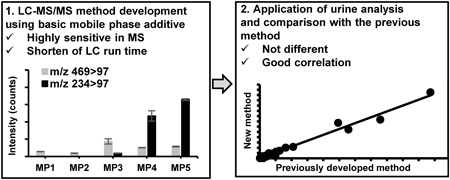- 著者
- Masamitsu Maekawa Keitaro Miyoshi Aya Narita Toshihiro Sato Yu Sato Masaki Kumondai Masafumi Kikuchi Katsumi Higaki Torayuki Okuyama Yoshikatsu Eto Hiroshi Sakamaki Nariyasu Mano
- 出版者
- The Pharmaceutical Society of Japan
- 雑誌
- Biological and Pharmaceutical Bulletin (ISSN:09186158)
- 巻号頁・発行日
- vol.45, no.9, pp.1259-1268, 2022-09-01 (Released:2022-09-01)
- 参考文献数
- 65
- 被引用文献数
- 3
As Niemann–Pick disease type C (NPC) is difficult to diagnose owing to its various clinical symptoms; biomarker tests have been developed. Previously, we revealed urinary sulfated cholesterol metabolites as noninvasive biomarkers for NPC. However, LC/tandem mass spectrometry (LC/MS/MS) requires long separation time and large urine volumes. Recently, a basic mobile phase was reported to increase the MS intensity. Thus, we developed a highly sensitive and rapid LC/MS/MS method for analyzing urinary cholesterol metabolites using a basic mobile phase additive. 3β-Sulfooxy-7β-N-acetylglucosaminyl-5-cholenic acid, its glycine and taurine conjugates, 3β-sulfooxy-7β-hydroxy-5-cholenic acid, and 7-oxo form were measured, with selected reaction monitoring in negative ion mode. Oasis HLB and L-column 3 were used for column-switching LC/MS/MS and urine diluted 10-fold was employed as the sample. After trapping, gradient separation was performed using solutions containing 1% (v/v) ammonium solution. On average, a 16-fold increase in peak areas was observed compared to that obtained at pH 5.5 with the mobile phases. Although the previous method needed 60 min for separation from interference peaks, we succeeded to separate them in 7 min with optimized LC condition. Further, all compounds showed good linearity from 0.3–1000 ng/mL, with satisfactory intra- and inter-day reproducibility. The developed method was applied to the urinalysis of healthy participants and NPC patients. Overall, the concentrations of metabolites correlated with those obtained using the previous method. Therefore, we succeeded to increasing MS intensity and shorten LC running time; and the method is useful for the noninvasive diagnostic screening of patients with NPC.
